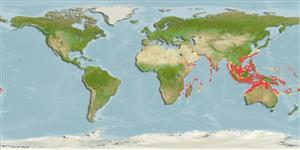Actinopterygii (peixes com raios nas barbatanas) >
Perciformes (Perch-likes) >
Caesionidae (Fusiliers) > Gymnocaesioninae
Etymology: Gymnocaesio: Greek, gymnos = naked + Latin, caesius, bluish-grey, 1835; it is the same name given to the silvery metal (Cs) (Ref. 45335).
Ambiente / Clima / Intervalo
Ecologia
; marinhas associadas(os) a recifes; não migratória; intervalo de profundidade 0 - 500 m (Ref. 402). Tropical, preferred ?; 31°N - 30°S, 32°E - 177°W (Ref. 402)
Indo-West Pacific: Red Sea and East Africa to Fiji, north to the Philippines.
Tamanho / Peso / Idade
Maturity: Lm ? range ? - ? cm
Max length : 18.0 cm TL macho/indeterminado; (Ref. 402)
Espinhos dorsais (total): 10 - 11; Raios dorsais (total): 14-16; Espinhos anais 3; Raios anais : 11 - 13.
Inhabits coastal areas around coral reefs (Ref. 30573). Feeds on zooplankton in large midwater aggregations. Forms schools with members of the genus Pterocaesio. Oviparous, with numerous, small pelagic eggs (Ref. 402). Often mistaken for juveniles and easily overlooked because of small size (Ref. 48636). Also caught with drive-in nets. Utilized as tuna bait fish (Ref. 30573).
Life cycle and mating behavior
Maturidade | Reprodução | Desova | Ovos | Fecundidade | Larvas
Carpenter, K.E., 1987. Revision of the Indo-Pacific fish family Caesionidae (Lutjanoidea), with descriptions of five new species. Indo-Pac. Fish. (15):56 p. (Ref. 1723)
Status na Lista Vermelha da IUCN (Ref. 115185)
CITES (Ref. 94142)
Not Evaluated
Perigo para os humanos
Harmless
Uso pelos humanos
Pescarias: pouco comercial; isca: usually
Mais informação
ReferênciasAquaculturaPerfil para aquaculturaEstirpesGenéticaFrequência alélicaHereditariedadeDoençasProcessamentoMass conversion
ColaboradoresFotosStamps, CoinsSonsCiguateraVelocidadeTipo de nataçãoÁrea branquialOtólitosCérebrosVisão
Ferramentas
Relatórios especiais
Baixar XML
Fontes da internet
